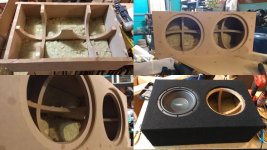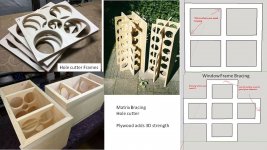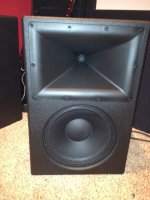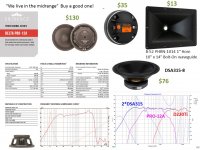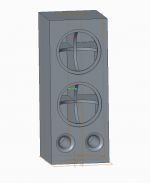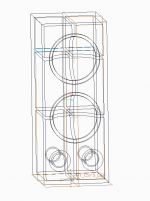Ok so my last thread was a disaster going up to 290 posts and long story short I will not be building the speakers I exactly wanted, instead I plan on building some monster subs and have them go along with my JBL LSR308 studio monitors. (I hope to be able to have the whole system go up to about 105dB to 110dB)
I already know how to use Unibox and plan on using 2 Dayton audio DSA315-8s per sub. (I'll have 2 total subs)
I have a good vented box plan with 160l and 31Hz Fb.
This is what I want to know...
1. How should I choose the subwoofer plate amp and how exactly would I connect it in parallel to the 2 woofers?
2. What type of external amp should I be looking at for the subs?
3. How will I make them work well with the JBLs? Like the 8" full range drivers on the JBLs can't play as loud as I want so how will I make the subs take that spot?
4. I am new to this diy speaker building so any additional information or article about bracing the enclosure and insulation etc... It all wasn't that clear in my last thread.
I already know how to use Unibox and plan on using 2 Dayton audio DSA315-8s per sub. (I'll have 2 total subs)
I have a good vented box plan with 160l and 31Hz Fb.
This is what I want to know...
1. How should I choose the subwoofer plate amp and how exactly would I connect it in parallel to the 2 woofers?
2. What type of external amp should I be looking at for the subs?
3. How will I make them work well with the JBLs? Like the 8" full range drivers on the JBLs can't play as loud as I want so how will I make the subs take that spot?
4. I am new to this diy speaker building so any additional information or article about bracing the enclosure and insulation etc... It all wasn't that clear in my last thread.
I suggest you add your budget and desired complexity level to post 1.
e.g. is post 6 of this too complex?
Very simple Yuan Jing build (noob questions)
For point 4, just look at good existing DIY builds (e.g. on this forum), or throw "DIY subwoofer bracing" into a Google image search. Copy from the best.
Buying / copying a simple commercial build is also an option:
Denovo Audio Knock-Down MDF 2.0 cu. ft. Subwoofer Cabinet for Dayton Audio 12" Ultimax Subwoofer
e.g. is post 6 of this too complex?
Very simple Yuan Jing build (noob questions)
For point 4, just look at good existing DIY builds (e.g. on this forum), or throw "DIY subwoofer bracing" into a Google image search. Copy from the best.
Buying / copying a simple commercial build is also an option:
Denovo Audio Knock-Down MDF 2.0 cu. ft. Subwoofer Cabinet for Dayton Audio 12" Ultimax Subwoofer
Last edited:
(That thread only goes up to 6 posts...)
I would hope to keep it all under $600, similar to my last thread. I already picked out my drivers anyway. I think I will also use MDF wood since it is a big enclosure still.
I have been told I am not the greatest at learning this stuff but I don't want to just give up and buy a premade box or one with pre cut out parts, I believe I am capable of doing that part, I guess I am too young to learn about building crossovers and the other parts though
I see a lot of different types of bracing on google, maybe I'll just go with the simple cross bracing with poles? It seems sturdy.
I would still appreciate help on the other questions I had. Thanks
I would hope to keep it all under $600, similar to my last thread. I already picked out my drivers anyway. I think I will also use MDF wood since it is a big enclosure still.
I have been told I am not the greatest at learning this stuff but I don't want to just give up and buy a premade box or one with pre cut out parts, I believe I am capable of doing that part, I guess I am too young to learn about building crossovers and the other parts though
I see a lot of different types of bracing on google, maybe I'll just go with the simple cross bracing with poles? It seems sturdy.
I would still appreciate help on the other questions I had. Thanks
A Man with a Plan.
One trip to the woodshop. (good name for a X-rated book?)
When you design and draw the plans for your dual DSA315-8 woofer cabinet, why not invest some time and design work into plans for a future matching midwoofer/waveguide top cabinet? The EconoWave threads have technical information and crossovers. Just cut the wood panels plus bracing for future glue-up and driver mounting.
MDF does not have great shear stress, so
1) construct a double thick front baffle. Angle cut the rear baffle board holes for good speaker air flow.
2) construct one U brace which goes around L+B+R panels between the two woofers.
3) construct one top-bottom center-panel brace
-------------
From Parts Express
4* Dayton DSA315-8 woofers =$300
miniDSP 2x4 Digital Signal Processor $105
Model: miniDSP 2x4|Part # 230-320
The box contains a printed certificate to download one plugin app.
(you need 12Volt wall-socket transformer for power)
Buy a used subwoofer amplifier from local Craig's List?? ebay??
MiniDSP should be able to blend in your powered JBL LSR308 Studio Monitors with the 12" woofers better than a plate amp. MiniDSP will also help you experiment with EconoWave designs.
One trip to the woodshop. (good name for a X-rated book?)
When you design and draw the plans for your dual DSA315-8 woofer cabinet, why not invest some time and design work into plans for a future matching midwoofer/waveguide top cabinet? The EconoWave threads have technical information and crossovers. Just cut the wood panels plus bracing for future glue-up and driver mounting.
MDF does not have great shear stress, so
1) construct a double thick front baffle. Angle cut the rear baffle board holes for good speaker air flow.
2) construct one U brace which goes around L+B+R panels between the two woofers.
3) construct one top-bottom center-panel brace
-------------
From Parts Express
4* Dayton DSA315-8 woofers =$300
miniDSP 2x4 Digital Signal Processor $105
Model: miniDSP 2x4|Part # 230-320
The box contains a printed certificate to download one plugin app.
(you need 12Volt wall-socket transformer for power)
Buy a used subwoofer amplifier from local Craig's List?? ebay??
MiniDSP should be able to blend in your powered JBL LSR308 Studio Monitors with the 12" woofers better than a plate amp. MiniDSP will also help you experiment with EconoWave designs.
...I guess I am too young to learn about building crossovers and the other parts though
You're never too young; I started getting into audio at nine. It's all about being patient, and taking the time to digest the information. Learning for the love of it helps a lot too: when it comes to recording and mixing, think of where you are now compared to when you started. Would you have made that progress if you had rushed to make a mix in a week and then moved on to something else?
To be sure, it's probably possible to learn how to design and build a set of speakers in a few months, but if what you want is to learn something on the subject, build a pair of speakers, and then move on to another interest... building a proven design is the path that will give a person a very good learning experience and a lot less headaches and frustration.
And since you just want to build a pair of subs for now, there's no reason you can't take the time to learn how to design a set of speakers and have that as a future project.
This is what I want to know...
1. How should I choose the subwoofer plate amp and how exactly would I connect it in parallel to the 2 woofers?
2. What type of external amp should I be looking at for the subs?
3. How will I make them work well with the JBLs? Like the 8" full range drivers on the JBLs can't play as loud as I want so how will I make the subs take that spot?
4. I am new to this diy speaker building so any additional information or article about bracing the enclosure and insulation etc... It all wasn't that clear in my last thread.
1 and 2: looking at a quick simulation of your proposed subs suggests that an amplifier with about 100 watts should get you where you want to be. Since the drivers are nominal 8 ohm, you would wire them in parallel, assuming the amplifier can handle a 4 ohm load. Speaking of amplifiers, if you're using a plate amp, you don't need an external one. And vice versa. Look for something that can do 100 watts into 4 ohms; stereo amplifier, plate amp, or pro amp, it doesn't really matter.
3. You need a crossover to restrict the amount of bass going to your JBL's and the amount of mids going to the subwoofers. Specifically, you need something that's stereo line level. A miniDSP would work, so would this.
4. Here's some detailed and deep information, and here's a thread on the topic.
I was mildly surprised at the lack of responses, then, as I was typing this, others replied, with some of the same suggestions I'm making 
1) I've had mixed luck with plate amps. Some are fine, and some are unworkable (or require troubleshooting), because they add hum or hiss to a system, even when no music is playing. This is usually a bigger problem for sensitive (loud) systems. Therefore future-proofing is something to consider: a plate amp that's OK now might be dodgy if you upgrade to a more sensitive top box in the future.
I don't know much about amps and electronics, but the signal:noise ratio in the specifications seems to be the best indicator of how much trouble an amp will be. Bad amps have a S:N of 90dB or worse, good amps are 100dB or better.
Very few plate amps are flexible enough for my needs - I often want to cross over at 300Hz or higher, and I also want eq, not just a simple crossover. Therefore, what I currently use is a miniDSP and one of these:
Dayton Audio DTA-120 Class T Mini Amplifier 60 WPC
At $200 all up, this is cheaper than getting 2 plate amps, is much more flexible, and (in my setup) has no hiss / noise. For LF I use 2x15" speakers running up to 500Hz. 60watts is plenty of power. In my current room, I need about 10dB of equalisation to get balanced lower mids and bass.
2) This is incompatable with question 1). You'd use a plate amp OR external amp for the bass box. I'm happy with the $80 60watt external amp I linked.
NOTE ON POWER: You're currently disortion limited to only using the 1st watt of the amps in your JBLs (for SPL in the 80s), so the 60watt amp I'm using should be plenty with 2x12" drivers.
One alternative is: you can get more power for less $ if you buy an amp board, and then finish it yourself, like in the thread I linked (that is: add your own power supply and case).
3) If you copy me, the miniDSP will sort that out. Use it between your source and the JBLs to filter (remove the lows) from the signal going to the JBLs. If you prefer to use plate amps, the answer will depend on which one you buy. Some of them filter the lows out of the signal going to the satellites.
4) This has been covered in many build threads + articles.
1) I've had mixed luck with plate amps. Some are fine, and some are unworkable (or require troubleshooting), because they add hum or hiss to a system, even when no music is playing. This is usually a bigger problem for sensitive (loud) systems. Therefore future-proofing is something to consider: a plate amp that's OK now might be dodgy if you upgrade to a more sensitive top box in the future.
I don't know much about amps and electronics, but the signal:noise ratio in the specifications seems to be the best indicator of how much trouble an amp will be. Bad amps have a S:N of 90dB or worse, good amps are 100dB or better.
Very few plate amps are flexible enough for my needs - I often want to cross over at 300Hz or higher, and I also want eq, not just a simple crossover. Therefore, what I currently use is a miniDSP and one of these:
Dayton Audio DTA-120 Class T Mini Amplifier 60 WPC
At $200 all up, this is cheaper than getting 2 plate amps, is much more flexible, and (in my setup) has no hiss / noise. For LF I use 2x15" speakers running up to 500Hz. 60watts is plenty of power. In my current room, I need about 10dB of equalisation to get balanced lower mids and bass.
2) This is incompatable with question 1). You'd use a plate amp OR external amp for the bass box. I'm happy with the $80 60watt external amp I linked.
NOTE ON POWER: You're currently disortion limited to only using the 1st watt of the amps in your JBLs (for SPL in the 80s), so the 60watt amp I'm using should be plenty with 2x12" drivers.
One alternative is: you can get more power for less $ if you buy an amp board, and then finish it yourself, like in the thread I linked (that is: add your own power supply and case).
3) If you copy me, the miniDSP will sort that out. Use it between your source and the JBLs to filter (remove the lows) from the signal going to the JBLs. If you prefer to use plate amps, the answer will depend on which one you buy. Some of them filter the lows out of the signal going to the satellites.
4) This has been covered in many build threads + articles.
Happy to see all these responses, I was getting a bit worried.
The BEHRINGER SUPER-X PRO CX3400 looks good with all the connections and crossover settings, it also isn't too expensive.
I am a bit confused about what you said with the JBLs. Are you saying the JBL's max SPL is only in the 80s? I am hoping to have them reach over 100dB for frequencies above like 100Hz...
Could you maybe attach some diagrams of the bracing you are talking about, I am having trouble picturing the placement of them...
Later I will run through all the connections in more detail but for now do I have this right?
-PC to mixer, mixer to 2 channel 31 band graphic equalizer, equalizer to amp, amp to JBLs and amp to terminals on sub woofer, terminals wired in parallel to each of the woofers...
The BEHRINGER SUPER-X PRO CX3400 looks good with all the connections and crossover settings, it also isn't too expensive.
I am a bit confused about what you said with the JBLs. Are you saying the JBL's max SPL is only in the 80s? I am hoping to have them reach over 100dB for frequencies above like 100Hz...
Could you maybe attach some diagrams of the bracing you are talking about, I am having trouble picturing the placement of them...
Later I will run through all the connections in more detail but for now do I have this right?
-PC to mixer, mixer to 2 channel 31 band graphic equalizer, equalizer to amp, amp to JBLs and amp to terminals on sub woofer, terminals wired in parallel to each of the woofers...
The BEHRINGER SUPER-X PRO CX3400 looks good with all the connections and crossover settings, it also isn't too expensive.
Note the (balanced) 3 pin connection types on the back. Might be awkward if your other gear has RCA connectors.
Mixing pro and home gear is a pain. I still have a bunch of adapter cables left over from trying this about 15 years ago. The sound quality was rubbish, I ended up selling off the (low end) pro crossover and 3x pro amps at a substantial loss.
Just repeating what was in the other thread. You said you listen at ~80dB, and the JBLs "clip" and sound bad if you turn them up to (?) level. The distortion measurements (given in post 221) indicate that, between 100-200Hz, they hit 3% distortion at 85-90dB, which is achieved with only 1 watt. So while they CAN play very loudly, it sounds like (in stock form) they are limited to about 1 watt if sound quality is important.I am a bit confused about what you said with the JBLs. Are you saying the JBL's max SPL is only in the 80s? I am hoping to have them reach over 100dB for frequencies above like 100Hz...
A humble <100 watt amp will go a LOT louder than 85-90dB, with a pair of well made 2x12" boxes.
-PC to mixer, mixer to 2 channel 31 band graphic equalizer, equalizer to amp, amp to JBLs and amp to terminals on sub woofer, terminals wired in parallel to each of the woofers...
a) If a PC is (always) the source, you don't need an equaliser. Anything an equaliser can do, (free) software can do.
b) I'd run:
PC to miniDSP ($95+ $10)
miniDSP --> JBLs
AND
miniDSP --> cheap (~$80) stereo amp --> bass boxes
Pretty simple, pretty cheap, and much better (in my limited experience) than budget pro gear.
Tomorrow i will do some exact box calculations and look into choosing the stuff but I am getting an equalizer just for my own purposes of listening to music and altering it how I want. I would rather do this with hardware rather than software that's all. I actually might scrap the idea if I don't want to pay for it, It would output the same 1/4" connections anyway.
Also they weren't clipping, I miss used the word. They were over excurting and moving more than I want them to.
I would be fine with the MiniDSP but that other crossover that aslepekis linked just seems like it would be better with more options and reviews say it has great quality. I am also not limited on desk space...
Also, in Unibox I have 70W put in with 2 drive units selected. I'm not sure if that 70w is for both of the woofers combined or just for one. This might play a factor in the amp.
Also(again) you skipped the mixer, this is something I already have Amazon.com: Pyle 8-Ch. Studio DJ Mixer [Audio Interface Mixing Sound System] Bluetooth Wireless Streaming | USB/Computer Connection Interface | Digital MP3 Support | +48V Phantom Power (PMXU83BT): Electronics
Also they weren't clipping, I miss used the word. They were over excurting and moving more than I want them to.
I would be fine with the MiniDSP but that other crossover that aslepekis linked just seems like it would be better with more options and reviews say it has great quality. I am also not limited on desk space...
Also, in Unibox I have 70W put in with 2 drive units selected. I'm not sure if that 70w is for both of the woofers combined or just for one. This might play a factor in the amp.
Also(again) you skipped the mixer, this is something I already have Amazon.com: Pyle 8-Ch. Studio DJ Mixer [Audio Interface Mixing Sound System] Bluetooth Wireless Streaming | USB/Computer Connection Interface | Digital MP3 Support | +48V Phantom Power (PMXU83BT): Electronics
Could you maybe attach some diagrams of the bracing you are talking about, I am having trouble picturing the placement of them...
MDF is easy to crack in half, SO simple "saber saw cut bracing" is typically glued to cabinet sides to increase sheer strength. A good construction example for your MDF materials and basic tools. dual12 pic
Plywood has good 3D strength, SO newer multi-hole matrix-grid bracing creates smaller panel areas which only generate low-energy high-frequency vibration. A drill press with a hole cutter speeds and simplifies the job.
----------
Plywood is a better speaker cabinet construction material than MDF.
HomeDepo has generic Birch plywood for about $55 for 4'x8' sheet. A simple black wood stain looks cool and still shows the wood grain. (painting MDF is a B-I-T-C-H)
Attachments
Seems odd (for someone making music in software), but OK.I would rather do this with hardware rather than software that's all.
Look again at the back panel. A 1/4" connection is basically a tubby headphone jack. If you look up "XLR cable", you'll see that they are different.It would output the same 1/4" connections anyway.
that other crossover that aslepekis linked just seems like it would be better with more options
To me, it appears to have fewer options. e.g. the crossover slopes are not adjustable, and it can't do notch filters.
Also(again) you skipped the mixer
The only source you listed was PC. If a PC is (always) the source, you don't need a mixer.
Do the cuts of the bracing have to be exact for the rounded parts?
And I will put my port in the back so is it ok for it to be off center?
Precision cuts on the bracing material are not critical, but you must leave enough wood thickness for good strength. The ports can be slightly off-center.
Two ports at the bottom-front of the woofer cabinet is probably the most common arrangement, since it helps even internal pressures which might side-side rock the cone suspension and damage the voice coils. The DSA315 are light weight musical woofers, not monster subwoofers with thick rubber surrounds.
===============
Start with a simple signal path to your new woofers before you decide to purchase mixer stuff.
From my personal experience, using multiple opamps to create complex crossovers with variable equalization and boost will significantly degrade the sound quality. Cheap opamps with cheap variable-resistors(twist knobs, and slide resistors) are very noisey. I would use a digital tool, either on a PC, or on a more expensive MiniDSP_HD type DSP engine.
GET MORE ADVICE from experts on music mix forums about digital vs. analog sound quality before you purchase.
Start with a simple signal path to your new woofers before you decide to purchase mixer stuff.
Precision cuts on the bracing material are not critical, but you must leave enough wood thickness for good strength. The ports can be slightly off-center.
Two ports at the bottom-front of the woofer cabinet is probably the most common arrangement, since it helps even internal pressures which might side-side rock the cone suspension and damage the voice coils. The DSA315 are light weight musical woofers, not monster subwoofers with thick rubber surrounds.
===============
Start with a simple signal path to your new woofers before you decide to purchase mixer stuff.
From my personal experience, using multiple opamps to create complex crossovers with variable equalization and boost will significantly degrade the sound quality. Cheap opamps with cheap variable-resistors(twist knobs, and slide resistors) are very noisey. I would use a digital tool, either on a PC, or on a more expensive MiniDSP_HD type DSP engine.
GET MORE ADVICE from experts on music mix forums about digital vs. analog sound quality before you purchase.
Start with a simple signal path to your new woofers before you decide to purchase mixer stuff.
Hi Linesource - how can I contact you privately? I own Apogees and wanted to chat w/ you about your solid state direct-drive amps amongst other things
-For any interested readers-A Man with a Plan.
When you design and draw the plans for your dual DSA315-8 woofer cabinet, why not invest some time and design work into plans for a future matching midwoofer/waveguide top cabinet? The EconoWave threads have technical information and crossovers. Just cut the wood panels plus bracing for future glue-up and driver mounting.
A sealed matching width cabinet ~1.2cuft total with ~1cuft net with drivers has -F3=110Hz
$13 B-52 PHRN-1014 1" Horn 10" x 14" Bolt-On waveguide
Model: PHRN-1014|Part # 299-2303
$34 Selenium 1" compression driver 2/3 Bolt . ( Proven Xover ckt available)
Selenium 8 Ohm Model: D220Ti-OMF-8 |Part # 299-2321
$130 Eminence Delta Pro 12A midrange 12"
Attachments
I already have a mixer which I linked in the first page. You can see the connections it has.
When I plug it into my PC with the USB there is almost no white noise.
How will I incorporate this into the setup. I payed $90 for it and I'm not going to put it aside!
I got it instead of an amp because I couldn't find any amps that had the right connections to the JBLs.
When I plug it into my PC with the USB there is almost no white noise.
How will I incorporate this into the setup. I payed $90 for it and I'm not going to put it aside!
I got it instead of an amp because I couldn't find any amps that had the right connections to the JBLs.
- Status
- This old topic is closed. If you want to reopen this topic, contact a moderator using the "Report Post" button.
- Home
- Loudspeakers
- Subwoofers
- Subwoofer Building Questions
